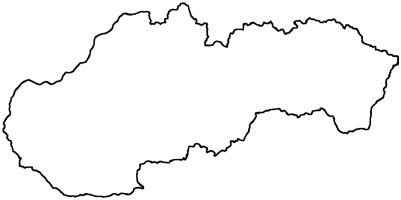
|
The Society of Folk Dance Historians (SFDH)
Slovakia:
[
Home |
About |
Encyclopedia | CLICK AN IMAGE TO ENLARGE |

|
 "It's Switzerland without the crowds – or the expense." The travel writers got it right. Slovakia is indeed one of Central Europe's treasures. A landlocked country wedged between Poland on the north, Hungary on the south, and Austria and Czech Republic on the west, Slovakia is a unique mix of cultures with its own character and some of Europe's most beautiful scenery.
"It's Switzerland without the crowds – or the expense." The travel writers got it right. Slovakia is indeed one of Central Europe's treasures. A landlocked country wedged between Poland on the north, Hungary on the south, and Austria and Czech Republic on the west, Slovakia is a unique mix of cultures with its own character and some of Europe's most beautiful scenery.
The spectacular Tatra Mountains, part of the Carpathian Range and comparable to our own Sierra Nevada Mountains, mark the border with Poland and, like Poland, host a livelihood and folklore of shepherds and foresters. Their dances are characterized by high leaps, brilliant displays of leg strength and dexterity with their shepherd's staffs and woodsmen's axes. Winter sports and unmatched Alpine scenery draw tourists from around the world.
Below the Tatras, the countryside descends in heavily forested rolling foothils to the fertile Danube River valley and the ragged border with Hungary to the south. Traditionally a pastoral, timber, and agricultural economy, Slovakia was the northern edge of the Austro-Hungarian Empire for centuries. Situated as it is in a long and narrow east-to-west direction on the very center of the European continent, this tiny country features a remarkably rich and diverse culture, well demonstrated in its folklore, music, and dance.
 The small industrial town of Detva, located in the south-central part of the country, has become a signature image of the country's folk. Though one of the most impoverished towns of the country, the dance and music of Detva display a wonderful image of the Slovak people. The dances are light-hearted, energetic, and fast. Men's costumes and dance are a show in gaiety. Long, white, loose-fitting trousers, a wide leather belt and a sternum-length shirt with open sleeves (and exposed belly) all richly embroidered, and embroidered vest and a jacket slung over the shoulder by a long strap, all topped by a jaunty little cap, create a strange "kroj" (pronounced "kroy"), or folk costume, unique to that area. Light leather shoes strapped to the ankle complete the ensemble, though occasionally boots are seen.
The small industrial town of Detva, located in the south-central part of the country, has become a signature image of the country's folk. Though one of the most impoverished towns of the country, the dance and music of Detva display a wonderful image of the Slovak people. The dances are light-hearted, energetic, and fast. Men's costumes and dance are a show in gaiety. Long, white, loose-fitting trousers, a wide leather belt and a sternum-length shirt with open sleeves (and exposed belly) all richly embroidered, and embroidered vest and a jacket slung over the shoulder by a long strap, all topped by a jaunty little cap, create a strange "kroj" (pronounced "kroy"), or folk costume, unique to that area. Light leather shoes strapped to the ankle complete the ensemble, though occasionally boots are seen.
And their dance! Seemingly without structure, the men engage in a carefree series of rapid "pas-de-basque," leaps, spins, high leaps and kicks, competing with each other, parts of the costume flying about them to accent the dance, and casually ending their brilliant displays with a nonchalance that adds to the nature of the dance – truly unique and uniquely Slovak.
Detva women wear a lovely blouse with beautifully embroidered sleeves, a richly embroidered and fitted brocade bodice and the familiar full skirt and apron. A soft shoe similar to the men's completes the "kroj."
The couple dances continue the carefree ebullience of the men's dance with rapid turns, separations, spins, and gymnastics that do not appear in other dances of Slovakia. Detva also is the home of the "fujara," a huge bassoon-like flute, held vertically in front of the body. Referred to as an "overtune flute," the instrument may be from three feet to over ten feet in length and requires a strong set of leather lungs to play its exotic and entrancing melodies. One simply must find a sample on the Internet to appreciate the music of this fascinating instrument, now finding its way into concert halls.
Much of the Slovak folk dance shows the Hungarian influence from the old empire; indeed there are still a large number of Hungarians living in Slovakia. The Čardáš (Csárdás in Hungarian) and Verbuňk (Verbunk in Hungarian) are there, as is the Karička (Karikázó in Hungarian), but they differ from the Hungarian dances in important ways that reveal the Slovak nature and personality.
The music is in a major key as opposed to the minor key of the Hungarian, giving the music a brighter character. Where the Hungarians are serious, earthy and intense, the Slovaks are carefree and joyous. Where lifts are rare in Hungarian dance, Slovak men love tossing their partners high in the air. In the Myjava area of western Slovakia, tossing the women has reached high art in a dance called Sellacky. The men assume a wide stance and the woman jumps to land on her knees on his thighs, bounce off, bounce on, and are then lifted high in the air as the man spins, balancing the woman on his raised thigh. The woman bounces back and forth between two men, face their partner, and change from one thigh to the other, bounce down a line of men, and frequently finish it off with a man lifting the woman to his shoulder.
Where the Hungarian Csárdás starts slowly and ends in a fast coda, the Slovak Čardáš begins fast and stays fast. Couples separate more frequently to allow displays of technique with a light-hearted interplay between partners.
The Slovak Verbuňk is frequently danced with spurs, not often found in Hungary, and the dance is more competitive and less structured, though the motifs are similar to the Kalotaségi Légéyes of Transylvania. The slapping patterns are a significant and popular motif.
The "kroj" is similar to the Hungarian, differing mostly in the style and amount of embellishment. Where the Hungarians are satisfied with a band of braid on the outside seam and a few loops in the front of the thigh of the men's trousers, the Slovaks decorate with a band of intricate patterns of black soutache and embroidery on white trousers. The black fedora is often decorated with a couple of long rooster tail feathers.
Women's bodices are often heavily adorned with embroidery, ruching, braid, ribbon, rosettes, sequins, and much more; sleeves display a lavish variety of heavy and intricate embroidery and cutwork in a rainbow of colors. The Hungarians look askance at such adornment.
Folk dress adornment reaches its highest level among the people of South Moravia, particularly in the Podluží region, which politically lies in the Czech Republic to the west. The Slovaks happily indulge in the richness of the overlapping cultures of their homeland. Their "kroj" became so ornate that the couple dance declined to almost nothing over concerns of disturbing the women's ornate, heavily starched and pleated blouses, flowing ribbons, and enormous pleated petticoats. Rather, couples stand side-by-side singing – and singing – before taking a very loose closed position and turning gently for a few measures, then returning to the singing.
The men's Verbuňk is a very personal dance, solo and competitive in nature – and interrupted by singing. The dance from different villages, even those almost within sight of each other, show distinctly different dance motifs, some twisting, some with large circular motifs, others spinning and leaping high into the air, all displaying the brilliance of their finery like so many strutting cocks.
Slovakia is dotted with isolated towns and villages that appear to have been lost in time. Čičmany is one such place and a place worth a visit. Not much is known of their dance, but the homes are still built of logs and decorated with ancient symbols to ward off evil spirits. Their embroidered costumes are very famous in Slovakia and you will be confronted with the artists when you arrive there in a tradition that goes back for decades.
The Širiš and Zemplín regions of eastern Slovakia are must-see tourist destinations with spectacular mountain scenery, charming villages, ancient wooden churches and historical sites, including Spišský Hrad, the largest fortified castle in Europe. These regions display a few unique and colorful dance forms of their own.
Most notable in Širiš is the Širiš Polka, a dance for active teenagers in good physical condition. Not a Polka at all, but an interesting blend of the dances of Poland to the north and Hungary to the south. Couples travel rapidly across the floor with a variety of quick, light figures, then stop and spin, twirl and boys lift the girls, then continue on. Exhilarating to watch, exhausting to dance.
In Zemplín, the area around the town of Košice is wine country that extends southward into Hungary's famed Tokaj area. It only makes sense that they would dance something about wine in a very entertaining Flaškovy. Wine bottles are placed on the floor in various patterns and the dancers display their dexterity – and affection for the wine – with a spectacle of booted legs twirling dangerously close around the bottles. As in the imaginative "girl tossing" of Myjava, the dancers create complex figures, hopping along lines of bottles, couples alternating leg circles around bottles, jumping over bottles, challenging and cooperating in figures to create one of the most entertaining dances of all.
A folklore festival shows the very best of Slovak, Moravian, and Czech folklore: the Strážnice International Folk Festival in South Moravia. Street parades, performances in the festival grounds, and all-night after parties will provide the very best opportunity to see dancers and costumes up close.
Following the Strážnice International Folk Festival is the Východná Folk Festival at the foot of the Tatra Mountains, a wonderful festival in an amphitheater with dance performances from all over Slovakia, Hungary, Poland, and more.
There is a reason that Vonnie Brown of Baton Rouge, Louisiana, spent every summer in Slovakia for over twenty years. There is a lovely charm about the country and its energetic, sweet folk dance.
DOCUMENTS
- Choreogeography: Czech Republic and Slovakia, an article.
- Dances of Slovakia, an article.
- Folk Dances of Czecho Slovakia, a book.
- Richard Duree, an article.
- Slovakia, a country.
Used with permission of the author.
Printed in Folk Dance Scene, March 2014.
This page © 2018 by Ron Houston.
Please do not copy any part of this page without including this copyright notice.
Please do not copy small portions out of context.
Please do not copy large portions without permission from Ron Houston.